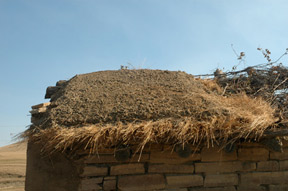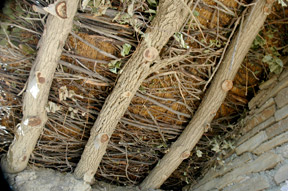The Hutmachers and the Hopi
Edward Crocker
I recently wrote, in this column, about two remarkable projects that we have undertaken that have some rather uncanny resemblances to two earlier jobs.
The first, as related last month, is the separated-at-birth resemblance between the adobe masonry style common to the Costilla County courthouse and the Otto Franc homestead near Cody, Wyoming. (In that instance I refrained from telling about Otto Franc von Lichtenstein's encounters with Butch Cassidy and how, after the baron made an honest but unfortunate ruling as the local Justice of the Peace, he was found shot to death, his own firearm resting against a fence next to the body.)
The second story was that of a farmhouse built in 1928 by a German immigrant family, the Hutmachers, in western North Dakota. That commentary expressed admiration for the audacity of anyone who would build a pitched earthen roof on the Great Plains where the onslaught of wind, rain, snow, sleet and hail made for incessant maintenance.
Naturally, there were reasons the Hutmachers built as they did. First, they were limited by the natural resources available to them. The second, and more profound, reason is that they were replicating a traditional architectural form that has its roots in the Black Sea region of the Ukraine and was brought to North Dakota by folk of German-Russian descent. The building tradition they carried to the Great Plains told them to build with pitched roofs, but the tradition did not prescribe the means and methods to do so half a world away from the archetypes in the Caucasus.
The result was that the Hutmachers, using what has at hand, piled a thick layer of rich clay over an underlayment of straw and brush at about a 30-degree angle. In form it was Caucasian in that it reflected the outward style. Functionally, however, it was (to quote two grand-daughters of the builder) ". . . a maintenance problem." The house is essentially buried on one side from the cascading clay. The other side, with the window and doors, was partially cleared, but remains rather bunker-like.
The present owner of the Farm, Preservation North Dakota, is charged with preserving the place, and readily concedes that they cannot afford the maintenance cycle demanded by the original materials. Conversely, they are completely averse to abandoning the essentials of an earthen roof. A dilemma, indeed.
When the executive director of PND called to enquire if I might be able to help, I was intrigued, not having ever heard of a pitched earthen roof, to say nothing of trying to restore one. But, as the synapses began to pop and crackle at the challenge, I postulated that the problem might be solved by borrowing an idea, a solid technology really, from the ancient Hopi Village of Oraibi.
Years ago, at the request of the owner, I "excavated" a flat earthen roof on a building that probably not been maintained for at least half a century. What I found was quite remarkable (you can read the story here). Earthen roofs are not simple constructs; on the contrary, the successful ones have a wonderfully thought-out stratigraphy. Essentially there are varying components of well-draining sandy clays, absorptive clay and virtually impermeable clays cleverly layered over the brush mat.


Using that model and modifying it to include a lime- and gravel-rich coat exposed to the weather, I am hopeful that we have lengthened the maintenance cycle to something PND can live with while not abandoning either the spirit or the specifics of the original. It will be very satisfying if a venerable Hopi technology provides a solution to the dilemma at Hutmacher.
Come spring, I'll let you know how it went.

